英语语法主谓一致
- 格式:doc
- 大小:40.50 KB
- 文档页数:8
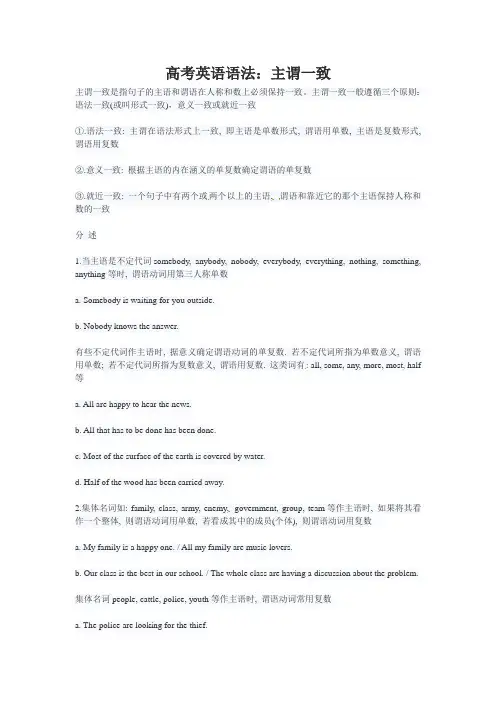
高考英语语法:主谓一致主谓一致是指句子的主语和谓语在人称和数上必须保持一致。
主谓一致一般遵循三个原则:语法一致(或叫形式一致),意义一致或就近一致①.语法一致: 主谓在语法形式上一致, 即主语是单数形式, 谓语用单数, 主语是复数形式, 谓语用复数②.意义一致: 根据主语的内在涵义的单复数确定谓语的单复数③.就近一致: 一个句子中有两个或两个以上的主语,谓语和靠近它的那个主语保持人称和数的一致分述1.当主语是不定代词somebody, anybody, nobody, everybody, everything, nothing, something, anything等时, 谓语动词用第三人称单数a. Somebody is waiting for you outside.b. Nobody knows the answer.有些不定代词作主语时, 据意义确定谓语动词的单复数. 若不定代词所指为单数意义, 谓语用单数; 若不定代词所指为复数意义, 谓语用复数. 这类词有: all, some, any, more, most, half 等a. All are happy to hear the news.b. All that has to be done has been done.c. Most of the surface of the earth is covered by water.d. Half of the wood has been carried away.2.集体名词如: family, class, army, enemy,government, group, team等作主语时, 如果将其看作一个整体, 则谓语动词用单数, 若看成其中的成员(个体), 则谓语动词用复数a. My family is a happy one. / All my family are music lovers.b. Our class is the best in our school. / The whole class are having a discussion about the problem.集体名词people, cattle, police, youth等作主语时, 谓语动词常用复数a. The police are looking for the thief.b. Cattle are not allowed to graze here.3.代词none和neither作主语时, 谓语动词根据说话人的意思用单数或复数. 当说话人着眼于任何一个都不时, 谓语动词用单数; 当说话人着眼于全都不时, 谓语动词用复数a. None of them has a car. ( 他们没有一个人有汽车)b. None of them have a car. ( 他们都没有汽车)c. None of them knows the answer. ( 他们两个谁也不知道答案)d. None of them know the answer. ( 他们两个都不知道答案)4.bothand连接两个主语时, 谓语动词通常用复数. eitheror, neithernor, not onlybut also, notbut 连接两个主语时, 采取就近原则, 即谓语动词和靠近它的那个主语保持一致a. Both Tom and Jerry were late for school that day.b. Either you or he has dropped waste paper in the street.c. Neither he nor I have forgotten for pay for the drinks.5.在There be和Here be结构中, 句子的主语在be之后, 如果主语不止一个, 那么谓语动词be与邻近的主语一致a. There is a desk, a table, three chairs in the room.b. There are three chairs, a desk and a table in the room.c. Here are two letters and a magazine for you.6.如果主语后面跟有with, together with, along with, as well as, but, except, besi des, including, like, rather than, no less than, in addition to(除外)等引导的短语时, 谓语动词的形式只与主语有关, 而与其后的短语无关a. The teacher with three student s was in the classroom then.b. This book, as well as the other two books, is borrowed from our school library.c. None but Jim and Mike knows my secret.d. Seven people, including a policeman, were killed.7.表示时间, 长度, 距离, 金额, 价值, 重量, 容量等的复数名词作主语时, 通常作整体看待, 即表示总量或总和, 谓语动词用单数. 若把它们看作一个个的个体, 即强调其具体数量时, 谓语动词用复数形式a. Twenty years is a long time to us.b. Two hundred miles is not a long distance.c. Ten thousand US dollars is a lot of money.d. There are ten minutes left.8.在四则运算中, 谓语动词用单复数均可, 但单数形式更为多用a. Two and ten is / are twelve.b. Three times five is / are fifteen.9.动名词或动词不定式作主语时, 谓语动词用单数a. Smoking / To smoke is a bad habit.b. Carving animal bones is not an easy job.10.主语从句作主语时, 谓语动词通常用单数. 但若主语从句所指的具体内容为复数意义时, 谓语动词用复数a. What we need is more time.b. What we need are more doctors.11.以-s结尾的专有名词作主语时, 谓语动词通常用单数, 这类专有名词如: General Motors(通用汽车公司), the United Nations(联合国), the United States, the New York Times(纽约时报)等.a. The New York Times is published daily.b. The Arabian Nights is a popular reading among the young people.表示群岛, 山脉, 瀑布的专有名词作主语时, 谓语动词通常用复数, 如:the Andes(安第斯山脉), the Alps(阿尔卑斯山脉), the West Indies(西印度群岛), the Niagara Falls(尼加拉大瀑布)12.有些形式为复数, 而意义为单数的名词作主语时, 谓语动词用单数. 这类名词如: news, works(工厂), politics(政治), physics(物理), mathematics(数学 )等13.以-s或-es结尾, 由对称的两部分构成的物体作主语时, 谓语动词用复数. 这类物体如: trousers, glasses, jeans(牛仔裤), scissors(剪刀), shades(太阳镜)等. 如果这类名词前用了pair, 则谓语动词的数取决于pair的数a. Here is a pair of glasses for you.b. There are three pairs of jeans in the bag.14. 分数或百分数+ of + 名词作主语时, 谓语动词视名词的可数与否采用单数或复数a. Over three quarters of the city was destroyed in the war.b. 35 percent of the do ctors are women.c. Thirty percent of the workers are out of work now.d. One third of the water has been wasted.15.用and连接两个或两个以上的单数名词作主语时, 谓语动词用复数. 如果and连接的两个名词指的是同一人、事、物或概念( 如: a knife and f ork一副刀叉, the bread and butter奶油面包, my house and home我的家)时, 则谓语动词用单数a. Many books and a pen are on the desk.b. The pianist and composer (钢琴家兼作曲家) has come to this small town.16. the + adj.表示一类人或事物作主语时, 谓语动词用复数. the +adj.若表示抽象概念或品质, 则谓语用单数a. The old in the city are taken good care of.b. The beautiful gives pleasure to all of us.美给我们以快乐17.more than one和many a + 单数名词作主语时, 谓语用单数a. Many a student has won the prize.很多学生获了奖b. More than one person has made the same mistake.不止一人犯了同样的错误。

主一致1.主一致是指英中在人称、数及意方面要与作主的名或代一致。
2.主一致分法一致、意一致、就近一致。
(1)法一致原:主和在法形式上保持一致。
主数,用数;主复数,用复数。
I often help him and he often helps me.(2)意一致原:主和在意上复数一致。
主数,用数;主复数,用复数。
The police are searching the woods for the murderer.(3)就近素来原:当主有两个或两个以上,由凑近它的主确定。
并列主的一致1.And(1)两个数名用and 接,表示不同样看法,用复数。
Tom and Jack are close friends.(2)两个数名用 and 接,表示同一歌人、同一个物,同一个看法,或表示不可以切割的整体,用数。
The singer and dancer is to attend our evening party.(3)被 every, each, many a, no 等限制的数名由 and 接,仍用数,其中,后一个限制可以省略。
every ⋯⋯ and ⋯⋯ every,each⋯⋯ and⋯⋯ each,no⋯⋯ and⋯⋯ no, many a⋯⋯ and⋯⋯ manya。
Each boy and (each) girl has an apple.(4)一个数名被几个用 and 接的并列形容修,可以指一件事或几件事,种名作主,要依照意一致的原决定复数。
(5)由 and 接的两个what 的从句作主,要依照意一致的原决定复数What he says and does do not agree.(言不衷心致)What he says and does does not concern me.2.由 either or, neither nor, not but, not only but also,or, nor接的并列主,常和近的主一致。

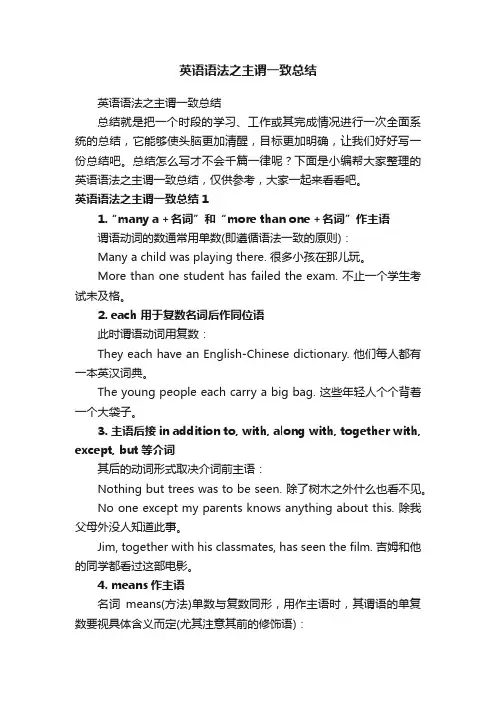
英语语法之主谓一致总结英语语法之主谓一致总结总结就是把一个时段的学习、工作或其完成情况进行一次全面系统的总结,它能够使头脑更加清醒,目标更加明确,让我们好好写一份总结吧。
总结怎么写才不会千篇一律呢?下面是小编帮大家整理的英语语法之主谓一致总结,仅供参考,大家一起来看看吧。
英语语法之主谓一致总结11.“many a +名词”和“more than one +名词”作主语谓语动词的数通常用单数(即遵循语法一致的原则):Many a child was playing there. 很多小孩在那儿玩。
More than one student has failed the exam. 不止一个学生考试未及格。
2. each 用于复数名词后作同位语此时谓语动词用复数:They each have an English-Chinese dictionary. 他们每人都有一本英汉词典。
The young people each carry a big bag. 这些年轻人个个背着一个大袋子。
3. 主语后接in addition to, with, along with, together with, except, but等介词其后的动词形式取决介词前主语:Nothing but trees was to be seen. 除了树木之外什么也看不见。
No one except my parents knows anything about this. 除我父母外没人知道此事。
Jim, together with his classmates, has seen the film. 吉姆和他的同学都看过这部电影。
4. means作主语名词means(方法)单数与复数同形,用作主语时,其谓语的单复数要视具体含义而定(尤其注意其前的修饰语):These means are very good. 这些方法很好。
Such a means is really unpleasant. 这样的方法确实是令人不愉快。
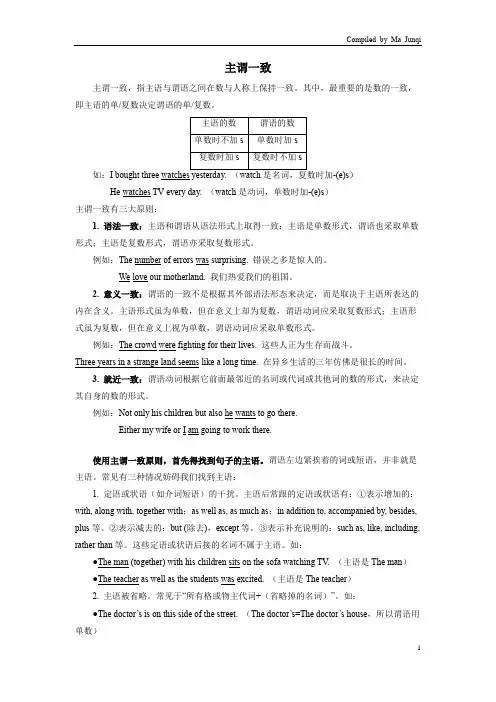
主谓一致主谓一致,指主语与谓语之间在数与人称上保持一致。
其中,最重要的是数的一致,即主语的单/复数决定谓语的单/复数。
如:I bought three watches yesterday. -(e)s)He watches TV every day. (watch是动词,单数时加-(e)s)主谓一致有三大原则:1. 语法一致:主语和谓语从语法形式上取得一致:主语是单数形式,谓语也采取单数形式;主语是复数形式,谓语亦采取复数形式。
例如:The number of errors was surprising. 错误之多是惊人的。
We love our motherland. 我们热爱我们的祖国。
2. 意义一致:谓语的一致不是根据其外部语法形态来决定,而是取决于主语所表达的内在含义。
主语形式虽为单数,但在意义上却为复数,谓语动词应采取复数形式;主语形式虽为复数,但在意义上视为单数,谓语动词应采取单数形式。
例如:The crowd were fighting for their lives. 这些人正为生存而战斗。
Three years in a strange land seems like a long time. 在异乡生活的三年仿佛是很长的时间。
3. 就近一致:谓语动词根据它前面最邻近的名词或代词或其他词的数的形式,来决定其自身的数的形式。
例如:Not only his children but also he wants to go there.Either my wife or I am going to work there.使用主谓一致原则,首先得找到句子的主语。
谓语左边紧挨着的词或短语,并非就是主语。
常见有三种情况妨碍我们找到主语:1. 定语或状语(如介词短语)的干扰。
主语后常跟的定语或状语有:①表示增加的:with, along with, together with;as well as, as much as;in addition to, accompanied by, besides, plus等。
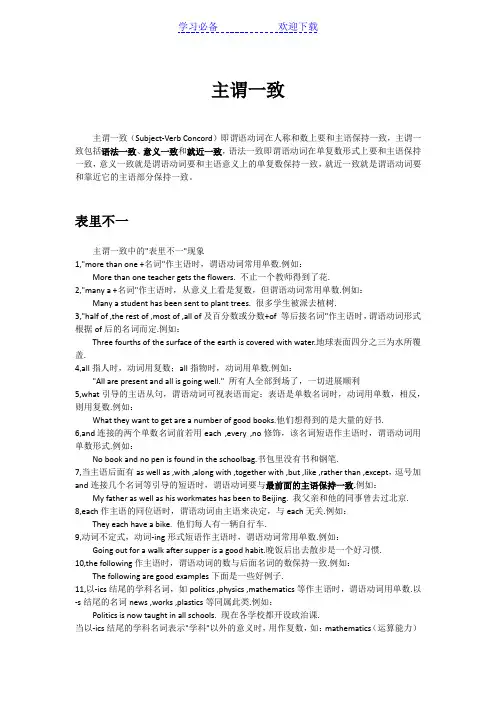
主谓一致主谓一致(Subject-Verb Concord)即谓语动词在人称和数上要和主语保持一致,主谓一致包括语法一致、意义一致和就近一致,语法一致即谓语动词在单复数形式上要和主语保持一致,意义一致就是谓语动词要和主语意义上的单复数保持一致,就近一致就是谓语动词要和靠近它的主语部分保持一致。
表里不一主谓一致中的"表里不一"现象1,"more than one +名词"作主语时,谓语动词常用单数.例如:More than one teacher gets the flowers. 不止一个教师得到了花.2,"many a +名词"作主语时,从意义上看是复数,但谓语动词常用单数.例如:Many a student has been sent to plant trees. 很多学生被派去植树.3,"half of ,the rest of ,most of ,all of及百分数或分数+of 等后接名词"作主语时,谓语动词形式根据of后的名词而定.例如:Three fourths of the surface of the earth is covered with water.地球表面四分之三为水所覆盖.4,all指人时,动词用复数;all指物时,动词用单数.例如:"All are present and all is going well." 所有人全部到场了,一切进展顺利5,what引导的主语从句,谓语动词可视表语而定:表语是单数名词时,动词用单数,相反,则用复数.例如:What they want to get are a number of good books.他们想得到的是大量的好书.6,and连接的两个单数名词前若用each ,every ,no修饰,该名词短语作主语时,谓语动词用单数形式.例如:No book and no pen is found in the schoolbag.书包里没有书和钢笔.7,当主语后面有as well as ,with ,along with ,together with ,but ,like ,rather than ,except,逗号加and连接几个名词等引导的短语时,谓语动词要与最前面的主语保持一致.例如:My father as well as his workmates has been to Beijing. 我父亲和他的同事曾去过北京. 8,each作主语的同位语时,谓语动词由主语来决定,与each无关.例如:They each have a bike. 他们每人有一辆自行车.9,动词不定式,动词-ing形式短语作主语时,谓语动词常用单数.例如:Going out for a walk after supper is a good habit.晚饭后出去散步是一个好习惯.10,the following作主语时,谓语动词的数与后面名词的数保持一致.例如:The following are good examples下面是一些好例子.11,以-ics结尾的学科名词,如politics ,physics ,mathematics等作主语时,谓语动词用单数.以-s结尾的名词news ,works ,plastics等同属此类.例如:Politics is now taught in all schools. 现在各学校都开设政治课.当以-ics结尾的学科名词表示"学科"以外的意义时,用作复数,如:mathematics(运算能力)politics(政治观点)economics(经济意义)等。
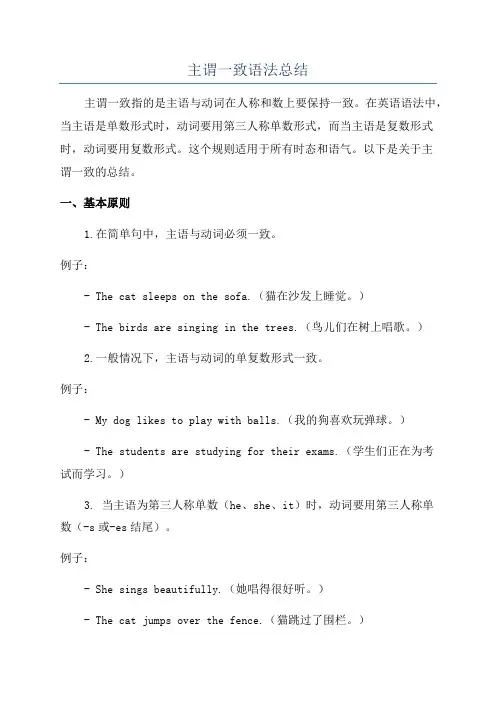
主谓一致语法总结主谓一致指的是主语与动词在人称和数上要保持一致。
在英语语法中,当主语是单数形式时,动词要用第三人称单数形式,而当主语是复数形式时,动词要用复数形式。
这个规则适用于所有时态和语气。
以下是关于主谓一致的总结。
一、基本原则1.在简单句中,主语与动词必须一致。
例子:- The cat sleeps on the sofa.(猫在沙发上睡觉。
)- The birds are singing in the trees.(鸟儿们在树上唱歌。
)2.一般情况下,主语与动词的单复数形式一致。
例子:- My dog likes to play with balls.(我的狗喜欢玩弹球。
)- The students are studying for their exams.(学生们正在为考试而学习。
)3. 当主语为第三人称单数(he、she、it)时,动词要用第三人称单数(-s或-es结尾)。
例子:- She sings beautifully.(她唱得很好听。
)- The cat jumps over the fence.(猫跳过了围栏。
)二、特殊情况1.当主语以复数形式出现,但表示一个整体或一个团体时,动词要用单数形式。
例子:- The team is training for the championship.(团队正在为锦标赛进行训练。
)2.有些名词看上去是复数形式,但实际上是单数形式,动词应该与它们保持单数一致。
例子:- Physics is my favorite subject.(物理是我最喜欢的科目。
)- News travels fast.(新闻传播很快。
)3.复合主语中的多个名词如果表示同一事物或一个整体,动词要用单数形式;如果表示不同事物或多个个体,动词要用复数形式。
例子:- My mother and I are going shopping.(我妈妈和我去购物。
)4.在倒装句中,助动词要与主语保持一致。
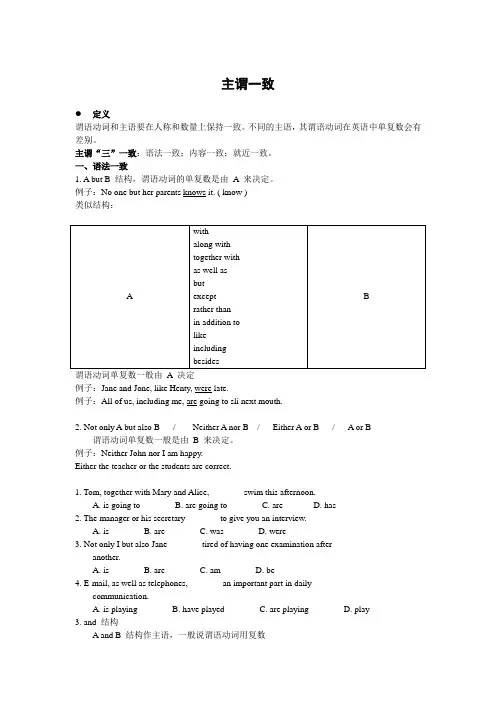
主谓一致定义谓语动词和主语要在人称和数量上保持一致。
不同的主语,其谓语动词在英语中单复数会有差别。
主谓“三”一致:语法一致;内容一致;就近一致。
一、语法一致1. A but B 结构,谓语动词的单复数是由A 来决定。
例子:No one but her parents knows it. ( know )类似结构:谓语动词单复数一般由A 决定例子:Jane and Jone, like Henty, were late.例子:All of us, including me, are going to sli next mouth.2. Not only A but also B / Neither A nor B / Either A or B / A or B谓语动词单复数一般是由B 来决定。
例子:Neither John nor I am happy.Either the teacher or the students are correct.1. Tom, together with Mary and Alice, _______ swim this afternoon.A. is going toB. are going toC. areD. has2. The manager or his secretary _______ to give you an interview.A. isB. areC. wasD. were3. Not only I but also Jane _______ tired of having one examination afteranother.A. isB. areC. amD. be4. E-mail, as well as telephones, _______ an important part in dailycommunication.A. is playingB. have playedC. are playingD. play3. and 结构A andB 结构作主语,一般说谓语动词用复数例:Tom and I are best friends.①看清到底是一个人还是两个人,通过定冠词来进行分析例题:The poet and writer has come. 表示一个人A poet and a writer have come.② each A and each B / every A and every B / many a A and many a B / no A and noB 作主语,谓语一般用单数例:Every man and every woman is asked to help.注意:many a 表示许多,等于 many③成对配套的可数名词后面一般用单数例:the knife and fork (刀叉)——> The knife and fork has been washed.a needle and thread 针线 a desk and chair 桌椅pen and ink 笔墨 a lock and key 锁和钥匙练习:1. A singer and dancer ___ present at the party.A. isB. areC. wasD. were2. Many a boy and many a student _______ looking forward to visiting theUnited States of America present.A. areB. wereC. isD. was3. The engineer and worker referred to ____ to design something.A. be goingB. are goingC. be likelyD. is going4. No bird and no beast _______ in the lonely island.A. are seenB. is seenC. seeD. sees4. 动名词/ 不定式/ 主语从句作主语,谓语动词一般用单数例:Walking is a good form of exercise.To perserve means victory.What I need is your love.练习:1. That they have cheated the boys ______ now clear to us all.A. isB. areC. wasD. were2. Writing stories and articles ______ what she enjoys most.A. isB. have beenC. wasD. were5. 如果名词被all / some / most / half / part / the rest / 分数/ 百分数等修饰时,谓语动词由主语决定。
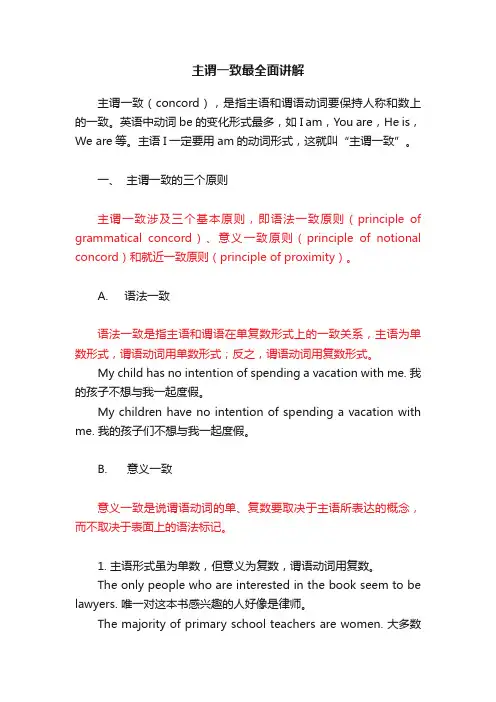
主谓一致最全面讲解主谓一致(concord),是指主语和谓语动词要保持人称和数上的一致。
英语中动词be的变化形式最多,如I am,You are,He is,We are等。
主语I一定要用am的动词形式,这就叫“主谓一致”。
一、主谓一致的三个原则主谓一致涉及三个基本原则,即语法一致原则(principle of grammatical concord)、意义一致原则(principle of notional concord)和就近一致原则(principle of proximity)。
A. 语法一致语法一致是指主语和谓语在单复数形式上的一致关系,主语为单数形式,谓语动词用单数形式;反之,谓语动词用复数形式。
My child has no intention of spending a vacation with me. 我的孩子不想与我一起度假。
My children have no intention of spending a vacation with me. 我的孩子们不想与我一起度假。
B. 意义一致意义一致是说谓语动词的单、复数要取决于主语所表达的概念,而不取决于表面上的语法标记。
1. 主语形式虽为单数,但意义为复数,谓语动词用复数。
The only people who are interested in the book seem to be lawyers. 唯一对这本书感兴趣的人好像是律师。
The majority of primary school teachers are women. 大多数小学老师都是女的。
2. 主语形式为复数,而意义上却是单数,谓语动词用单数。
Billiards is becoming more and more popular in some cities. 桌球在一些城市里越来越受欢迎。
C. 就近一致就近一致是指当主语由两个或两个以上名词或代词组成时,谓语动词的数要与它紧邻的名词或代词的数一致。

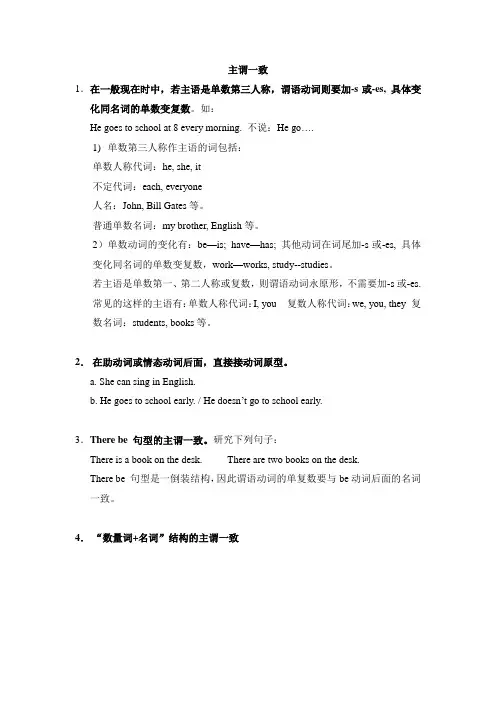
主谓一致1.在一般现在时中,若主语是单数第三人称,谓语动词则要加-s或-es, 具体变化同名词的单数变复数。
如:He goes to school at 8 every morning. 不说:He go….1)单数第三人称作主语的词包括:单数人称代词:he, she, it不定代词:each, everyone人名:John, Bill Gates等。
普通单数名词:my brother, English等。
2)单数动词的变化有:be—is; have—has; 其他动词在词尾加-s或-es, 具体变化同名词的单数变复数,work—works, study--studies。
若主语是单数第一、第二人称或复数,则谓语动词永原形,不需要加-s或-es.常见的这样的主语有:单数人称代词:I, you 复数人称代词:we, you, they 复数名词:students, books等。
2.在助动词或情态动词后面,直接接动词原型。
a. She can sing in English.b. He goes to school early. / He doesn’t go to school early.3.There be 句型的主谓一致。
研究下列句子:There is a book on the desk. There are two books on the desk.There be 句型是一倒装结构,因此谓语动词的单复数要与be动词后面的名词一致。
4.“数量词+名词”结构的主谓一致在上述数量词中,有些还可以接of 短语连用。
具体用法如下:5.单数形式的名词作主语与谓语动词形式的关系一般来说,单数名词作主语,谓语动词用单数形式,这个符合英语中的语法上一致原则。
但此种情况也有例外。
现在详细归纳如下:1)Many a +名词单数,虽为复数概念,但谓语用单数。
a.There is many an error that he has neglected.b.Many a man and (many a) woman has wished that he or she had had abetter education. (Many men and women have….)2)More than one+可数名词单数,是复数概念,但谓语用单数。
主谓一致的规则及应用主谓一致是英语语法中的基本规则,指的是主语与谓语在人称和数上保持一致。
正确运用主谓一致规则会增强句子的准确性和流畅性,使表达更加清晰。
本文将介绍主谓一致的规则,并给出一些应用实例。
一、基本规则1. 单数主语与单数谓语动词一致。
例如:- The cat is sleeping.(这只猫在睡觉。
)- She runs every morning.(她每天早上跑步。
)2. 复数主语与复数谓语动词一致。
例如:- The students are studying in the library.(学生们正在图书馆学习。
)- They play football every weekend.(他们每个周末踢足球。
)3. 不可数名词作主语时,谓语动词通常使用单数形式。
例如:- Rice is a staple food in many countries.(米饭是许多国家的主食。
)- Water is essential for life.(水对生命至关重要。
)4. 用作主语的不定代词通常与单数谓语动词一致。
例如:- Everyone wants to be happy.(每个人都想要快乐。
)- Somebody has left their bag here.(有人把包落在这里了。
)5. 连接词and连接的两个主语,谓语动词通常与复数一致。
例如:- Tom and Jerry are good friends.(汤姆和杰瑞是好朋友。
)- My mom and dad like gardening.(我爸爸妈妈喜欢园艺。
)二、特殊情况1. 数量词、百分数加名词短语作主语时,谓语动词取决于名词短语中的名词单复数形式。
例如:- Fifty percent of the students are girls.(百分之五十的学生是女孩。
)- A lot of money has been spent on this project.(这个项目花费了很多钱。
主谓一致主谓一致Subject-Verb Concord即谓语动词在人称和数上要和主语保持一致;主谓一致包括语法一致、意义一致和就近一致;语法一致即谓语动词在单复数形式上要和主语保持一致;意义一致就是谓语动词要和主语意义上的单复数保持一致;就近一致就是谓语动词要和靠近它的主语部分保持一致..表里不一主谓一致中的"表里不一"现象1;"more than one +名词"作主语时;谓语动词常用单数.例如:More than one teacher gets the flowers. 不止一个教师得到了花. 2;"many a +名词"作主语时;从意义上看是复数;但谓语动词常用单数.例如:Many a student has been sent to plant trees. 很多学生被派去植树.3;"half of ;the rest of ;most of ;all of及百分数或分数+of 等后接名词"作主语时;谓语动词形式根据of后的名词而定.例如:Three fourths of the surface of the earth is covered with water.地球表面四分之三为水所覆盖.4;all指人时;动词用复数;all指物时;动词用单数.例如:"All are present and all is going well." 所有人全部到场了;一切进展顺利5;what引导的主语从句;谓语动词可视表语而定:表语是单数名词时;动词用单数;相反;则用复数.例如:What they want to get are a number of good books.他们想得到的是大量的好书.6;and连接的两个单数名词前若用each ;every ;no修饰;该名词短语作主语时;谓语动词用单数形式.例如:No book and no pen is found in the schoolbag.书包里没有书和钢笔.7;当主语后面有as well as ;with ;along with ;together with ;but ;like ;rather than ;except;逗号加and连接几个名词等引导的短语时;谓语动词要与最前面的主语保持一致.例如:My father as well as his workmates has been to Beijing. 我父亲和他的同事曾去过北京.8;each作主语的同位语时;谓语动词由主语来决定;与each无关.例如:They each have a bike. 他们每人有一辆自行车.9;动词不定式;动词-ing形式短语作主语时;谓语动词常用单数.例如:Going out for a walk after supper is a good habit.晚饭后出去散步是一个好习惯.10;the following作主语时;谓语动词的数与后面名词的数保持一致.例如:The following are good examples下面是一些好例子.11;以-ics结尾的学科名词;如politics ;physics ;mathematics等作主语时;谓语动词用单数.以-s结尾的名词news ;works ;plastics等同属此类.例如:Politics is now taught in all schools. 现在各学校都开设政治课.当以-ics结尾的学科名词表示"学科"以外的意义时;用作复数;如:mathematics运算能力politics政治观点economics经济意义等..12;有些用来表示由两个对应部分组成一体的名词复数trousers ;glasses ;shoes .shorts .scissors .scales等作主语时;前面若有"一条";"一副";"一把"之类的单位词;动词用单数;若没有单位词或单位词是复数;则谓语动词用复数.例如:The shoes are all right. 这些鞋子都很合适.还有一些以-s结尾的名词通常用复数:arms武器.clothes .contents .minutes记录.remains遗体.thanks等13;"one and a half +名词"作主语时;谓语动词要用单数.例如:One and a half apples is left on the table. 桌子上有一个半苹果.14;"One or two more +复数名词"作主语时;谓语动词用复数.例如:One or two persons are sent there to help them do the work. 要派一两个人到那儿去给他们帮忙.15;"one of+复数名词+ 定语从句"结构中;定语从句的谓语动词要用复数;而在"the only one of +复数名词+定语从句"的结构中;"the one of + 复数名词+定语从句"定语从句的谓语动词要用单数.例如:He is one of the students who get there on time.他是准时到达那里的学生之一.16;表示时间;距离;金钱等的复数名词作主语表达一个整体概念时;谓语动词常用单数;但若强调数量;谓语动词可用复数.例如:One million dollars is a lot of money. 一百万美元是一大笔钱. -s结尾一以-s结尾的疾病名称作主语的主谓一致问题;以-s结尾的疾病名称作主语的主谓一致问题;如:arthritis ;bronchitis ;diabetes ;mumps ;phlebitis ;rickets;这类以-s结尾的疾病名称作主语时;谓语动词通常用作单数..例如:Arthritis causes great pain in the joints of the patient.二以-s结尾的游戏名称作主语的主谓一致问题;以-s结尾的游戏名称作主语时;谓语动词通常用作单数..例如:Darts is basically an easy game.但当Darts;Marbles等的意义为游戏器具而非游戏名称时;谓语动词通常用作复数..例如:Three darts are thrown at each turn.All nine skittles were brought down by the good throw.三以-s结尾的地理名称作主语的主谓一致问题;某些以-s结尾的地理名称;如果是国名;如the United States;the Netherlands等;因其是单一政治实体;所以谓语动词用作单数..例如:The United States was hit by the Great Depression in 1930s'.In early January 1996 the Netherlands was hit by its worst storm since 1976.但如果是群岛、山脉、海峡、瀑布等地理名称作主语;谓语动词用作复数..例如:The West Indies are commonly divided into two parts.四以-ics结尾的学科名称作主语的主谓一致问题;某些以-ics结尾的学科名称作主语时;如physics ;mathematics ;mechanics ;optics ;acoustics ;politics;st atistics ;economics ;linguistics ;athletics等;谓语动词通常用作单数..例如:The third world economics is promising.Athletics is a required course for students of all grades.但如果这类名词表示学科以外的其它含义;可作复数用..例如:Athletics have been greatly encouraged at this college.五其它以-s结尾的名词的主谓一致问题;.以-s结尾的由两部分组成的物体名称作主语;英语中有一些通常以-s结尾的由两部分组成的物体名词;如glasses ;pincers ;pliers ;scissors ;shorts ;suspenders ;trousers 等; 为复数名词;后接复数谓语集合名词1单数—复数型.凡是有复数词尾变化形式的集合名词都属于此类.如:a class—classes; a family—families; a government—governments; anarmy—armies ;a people—peoples民族; a group—groups; a crowd—crowds; a crew—crews等.这类集合名词强调的是整体性;即当作一个整体或多个整体来看待.属于这类集合名词的单数作主语时;谓语动词用单数;复数形式作主语时;谓语动词用复数.例如A big crowd often gathers on the square every morning.每个上午一大群人经常聚集在广场上The government has decided to pass the bill.政府已决定通过这一法案There are huge crowds in the streets on Sunday.星期天有大群大群的人在街上..There are many English-speaking peoples in the world.在世界上有许多讲英语的民族..但应注意;这类集合名词的单数形式有时表示复数概念;所以这些集合名词的单数形式也可归为"单复同形型"中.2单数型.这类集合名词表示的是人或事物的整体;即把这类人或事物的全部包括在内;所以只有单数形式.如作主语;谓语动词常用单数.这类名词常见的有:humanity ;mankind ;proletariat等.例如The proletariat is the greatest class in the history of mankind. In the fields of production and scientific experiment ;mankind makes constant progress.3复数型.这类集合名词在形式和内容上是相互矛盾的;就是说它们只有单数形式;但表达的都是复数概念.它强调的是集体中的个体性.这类名词有:police ;cattle ;faculty ;flock ;machinery ;vermin ;personnel等.它们作主语时;谓语动词要用复数.例如The police have caught the murder.Our personnel are very highly trained.The vermin are very dangerous.4单复同形型.这类集合名词的单数形式既可表示单数也可表示复数.作主语时;用单数动词或复数动词均可;有时意义区别不大;具体看语境;是强调集体还是个体..例如The school teaching staff are is excellent.The public is are requested not to litter in the park.The teaching profession claims to be badly paid.这类集合名词常见的有:class;family;team;crew;board;herd;committee;party;jury;enemy;au dience等.根据说话人的心理意向若把这个集合名词所代表的人或事物看作一个整体;就认为是单数;用单数动词;若把它所代表的人或事物看作若干个个体的话;就认为其为复数;用复数动词.试比较:The football team is playing well.那个足球队打得非常漂亮. The football team are shavings bath and are then coming back here for tea. 足球队员们正在洗澡;然后来这里吃茶点.The family is a very happy one.那个家庭是一个非常幸福的家庭.That family are very pleased about the news of William's success. 全家人对威廉的成功都感到很高兴.典型例题1 并列结构作主语时谓语用复数Reading and writing are very important.注意:当主语由and连接时;如果它表示一个单一的概念;即指同一人或同一物时;谓语动词用is;and 此时连接的两个词前只有一个冠词;共用一个冠词用单数;表示The iron and steel industry is very important to our life.The League secretary and monitor ___ asked to make a speech at the meeting.A. isB. wasC. areD. were答案 B. 注:先从时态上考虑.这是过去发生的事情应用过去时;先排除A.;C..本题易误选D;因为The League secretary and monitor 好象是两个人;但仔细辨别;monitor 前没有the;在英语中;当一人兼数职时只在第一个职务前加定冠词.后面的职务用and 相连.这样本题主语为一个人;所以应选B.2 主谓一致中的就近原则当there be 句型的主语是一系列事物时;谓语应与最邻近的主语保持一致.There is a pen;a knife and several books on the desk..There are twenty boy-students and twenty-three girl-students in the class.总的来说;在由not only…but also…;not just…but…;or;either…or…;neither…nor…连接主语的句子中及在there be句型中;谓语动词的单复数按就近原则处理;即按与谓语动词最靠近的那个主语来确定谓语动词的单复数形式..如:Not only John but also I am going to Shanghai next week.Either you or she is to go.There is a pen ;a few envelops and some paper for you.3 谓语动词与前面的主语一致当主语后面跟有with ;together with ;like; except ;but ;no less than ;as well as 等词引起的短语时;谓语动词与前面的主语一致.The teacher together with some students is visiting the factory. He as well as I wants to go boating.4 谓语需用单数1 代词each和由every ;some ;no ;any等构成的复合代词作主语;或主语中含有each ;every;谓语需用单数.Each of us has a tape-recorder.There is something wrong with my watch.2 当主语是一本书或一条格言时;谓语动词常用单数.The Arabian Night is a book known to lovers of English.<一千零一夜>是英语爱好者熟悉的一本好书.3 表示金钱;时间.距离.价格或度量衡的复合名词作主语时;通常把这些名词看作一个整体;谓语一般用单数.用复数也可;意思不变.Three weeks was allowed for making the necessary preparations. Ten yuan is enough.5 指代意义决定谓语的单复数1 在代词what ;which ;who ;none ;some ;any ;more ;most ;all等词的单复数由其指代的词的单复数决定.All is right. 一切顺利.All are present. 所有人都到齐了.2 集体名词作主语时;谓语的数要根据主语的意思来决定.如family ;team;group;club ;public ;audience ;crew ;crowd ;class ; company ;committee等词后用复数形式时;意为这个集体中的各个成员;用单数时表示该个集体.His family isn't very large. 他家不是一个大家庭.His family are music lovers. 他的家人都是音乐爱好者.但集合名词people ;police ;cattle ;poultry家禽.militia民兵.vermin 害虫等在任何情况下都用复数形式.Are there any police around3有些名词;如variety ;number ;population ;proportion ;majority 等有时看作单数;有时看作复数.A number of +名词复数+动词的第三人称单数形式.The number of +名词复数+动词非第三人称单数形式.A number of books have lent out.The majority of the students like English.6 与后接名词或代词保持一致1 用half of; part of ;most of ;a portion of 等词引起主语时;动词通常与of后面的名词;代词保持一致.Most of his money is spent on books.Most of the students are taking an active part in sports.2 在一些短语;如 many a 或 more than one 所修饰的词作主语时;谓语动词多用单数形式.但由more than… of 作主语时;动词应与其后的名词或代词保持一致.Many a person has read the novel. 许多人都读过这本书.More than 60 percent of the students are from the city.百分之六十多的学生都来自这个城市.7 the+形容词/国籍形容词..表示一类人/一国人;作主语;谓语动词用复数..8 the+姓氏的复数;表示一家人或两夫妇;作主语时;谓语动词用复数;9四则运算时;谓语动词用单数..10 表示;时间;距离;重量;金额;书名的复数名词作主语时;通常当做整体看待;谓语动词用单数..。
英语语法主谓一致精讲主谓一致(Subject- Verb Agreement),指”人称”和”数方面的一致关系.如: He is going abroad. They are playing football.可分为:语法一致, 内容一致, 就近一致.(一) 语法一致原则: 即主语为单数,谓语用单数,主语为复数,谓语也用复数. 以下为注意事项:1. 单数主语即使后面带有with , along with, together with, like(象), but (除了),except, besides, as well as, no less than, rather than(而不是), including, in addition to 引导的短语, 谓语动词仍用单数.如: Air as well as water is matter. 空气和水都是物质.No one except two servants was late for the dinner. 除了两个仆人外, 没有一个人迟来用餐。
2. 用and连接的并列主语,如果主语是同一个人,同一事,同一概念, 谓语动词用单数, 否则用复数. 如: The poet and writer has come. 那位诗人兼作家来了.(一个人)A hammer and a saw are useful tools. 锤子和锯都是有用的工具. (两样物)用and连接的成对名词习惯上被看成是一个整体, 如:bread and butter(黄油抹面包), knife and fork(刀叉)等作主语时, 谓语动词用单数。
3. 不定式(短语), 动名词(短语), 或从句作主语时, 谓语动词用单数. 如:Serving the people is my great happiness.为人民服务是我最大的幸福.When we’ll go out for an outing has been decided.我们什么时候出去郊游已决定了。
英语语法总结主谓一致英语语法总结主谓一致总结就是对一个时期的学习、工作或其完成情况进行一次全面系统的回顾和分析的书面材料,它可以有效锻炼我们的语言组织能力,让我们一起来学习写总结吧。
那么总结要注意有什么内容呢?下面是店铺整理的英语语法总结主谓一致,仅供参考,欢迎大家阅读。
英语语法总结主谓一致11.主语是he ,she, it, either, neither, each, anything, something, everything, nothing, someone, everyone, anyone, nobody, no one, 等代词时,谓语动词用单数。
Someone is asking for you. 有人在找你。
Everyone is here. 大家都来了。
Each of the boys has an apple.2. 表示总称意义的名词people, cattle, police做主语时,谓语动词用复数。
Cattle are farmer’s friends.The policeman is standing at the street corner. The police are searching for him.3. 主语是:时间,距离,价格等名词,即使是复数形式,谓语动词只用单数。
Three years passes quickly.Two meters is not long enough.4.主语是:clothes, glasses, trousers, shoes, socks, gloves 等名词时,谓语动词用复数。
The trousers are not expensive.Your socks are over there.5.主语是:family, class, team, group等名词时,如果是作为整体,谓语动词用单数;如果作为其中一个个的成员,谓语动词用复数。
英语语法主谓一致第一讲主谓一致“一致”(Concord 或Agreement)是指句子成分之间词语之间在语法形式上的协调关系。
主要有主语与动词的一致,主语与补语的一致,限定词与名词中心词的一致,人称代词与并列和非并列先行词的一致,名词与名词或代词的一致。
“主谓一致”是指主语和谓语动词之间在人称和数的方面的一致关系,这又叫做“主——动一致”(Subject——verb Concord)。
1. 主谓一致三原则主语和随后的动词(词组),即谓语动词之间的一致关系常为三种不同的原则所支配,即语法一致原则(Grammar Concord),意义一致原则(Notional Concord)和就近原则(Principle of Proximity)。
1.1 语法一致指作主语的名词中心词是复数,动词就用复数形式;如果名词中心词是单数名词或不可数名词,动词就用单数形式。
例如:Both boys have their own merits.In my heart are peace and goodwill.The elevator works very well.Much effort is wasted.1.2 意义∕概念一直指主语和动词的一致关系并非取决于语法上的单、复数形式,而是取决于主语的单、复数意义。
有时主语在语法形式上并非复数,但有复数意义,随后的动词就用复数;主语在语法形式上是复数,而在意义上可视为单数,随后的动词用单数。
例如:The jury has asked more time.The jury are unable to agree.Fifty minutes isn’t enough time to finish this test.“ Senior citizens” means people over sixty.1.3 就近原则指谓语动词的单、复数形式取决于最靠近它的词语的单、复数形式,而不是与充当主语的名词短语中心词相一致。
主谓一致语法一致原则在英语语法中,主谓一致是指主语和谓语在人称和数上要保持一致。
这是一条基本的语法规则,也是英语句子正确表达的重要要素之一。
主谓一致语法一致原则在写作中起到了重要的作用,使句子更加清晰、准确、易于理解。
主谓一致语法一致原则可以应用于不同的句子结构和各种时态。
在下面的几个例子中,我们将详细介绍这一原则的应用。
1. 一般现在时在一般现在时中,主谓一致的原则是:单数主语使用单数谓语动词,复数主语使用复数谓语动词。
例如:- The cat sleeps on the sofa. (猫在沙发上睡觉。
)- The students study hard for the exam. (学生们为了考试努力学习。
)2. 现在进行时在现在进行时中,主谓一致的原则是:单数主语使用单数谓语动词+ing形式,复数主语使用复数谓语动词+ing形式。
例如:- She is watching TV. (她正在看电视。
)- They are playing basketball. (他们正在打篮球。
)3. 一般过去时在一般过去时中,主谓一致的原则是:不论主语是单数还是复数,谓语动词都使用过去式。
例如:- He visited his grandparents last week. (他上周去看望了他的祖父母。
)- They played soccer in the park yesterday. (他们昨天在公园里踢足球。
)4. 过去进行时在过去进行时中,主谓一致的原则是:不论主语是单数还是复数,谓语动词都使用过去式+ing形式。
例如:- She was reading a book when I called her. (我给她打电话的时候她正在读书。
)- They were having dinner when the power went out. (停电的时候他们正在吃晚饭。
)5. 将来时在将来时中,主谓一致的原则是:不论主语是单数还是复数,谓语动词都使用将来时态的形式。
1.主谓一致是指英语中谓语在人称、数及意义方面要与作主语的名词或代词一致。
2.主谓一致分为语法一致、意义一致、就近一致。
(1)语法一致原则:主语和谓语在语法形式上保持一致。
主语为单数,谓语用单数;主语为复数,谓语用复数。
I often help him and he often helps me.(2)意义一致原则:主语和谓语在意义上单复数一致。
主语为单数,谓语用单数;主语为复数,谓语用复数。
The police are searching the woods for the murderer.(3)(4)就近一直原则:当主语有两个或两个以上时,谓语动词由靠近它的主语确定。
蕿并列主语的谓语一致1.2.And(1)两个单数名词用and连接,表示不同概念时,谓语用发复数。
Tom and Jack are close friends.(2)(3)两个单数名词用and连接,表示同一歌人、同一个物,同一个概念,或表示不可分割的整体时,谓语用单数。
The singer and dancer is to attend our evening party.(4)(5)被every,each,many a,no等限定的单数名词由and连接时,谓语仍用单数,其中,后一个限定词可以省略。
every ……and ……every,each……and……each,no……and……no, many a……and……many a。
Each boy and (each) girl has an apple.(6)(7)一个单数名词被几个用and连接的并列形容词修饰时,可以指一件事或几件事,这种名词作主语,要根据意义一致的原则决定单复数。
Simple and plain living is a fine quality.生活简朴一种优良品质。
Ancient and modern history are the subjects we are studying.(8)(9)由and连接的两个what的从句作主语时,要根据意义一致的原则决定单复数What he says and does do not agree.(言行不一致)What he says and does does not concern me.2.3.由either or, neither nor, not but, not only but also,or, nor连接的并列主语,谓语动词常和邻近的主语一致。
Either Tom or I is going there.3、4、“with/along with/together with/as well as/as much as/expect/besides/including/rather than/but/等+名词”结构时,谓语单复数不受这些词影响。
You father as well as you is very kind to me,某些名词作主语时的主谓一致1.2.集合名词(1)(2)表示整体概念,强调一致性,谓语动词用单数形式;强调每一个成员,谓语动词用复数。
如:family,company, committee, government, nation,Group,team, class, grade,Population, army, audience.Our class consists of 25 girls and 25 boys.Our class are playing football.(3)(4)有些有生命的集合名词作主语时,谓语动词用复数形式。
如:people, police,cattleThe cattle are grazing in the field.2、表示成双成套的名词,如:trousers,shoes,glasses,socks stockings,scissor单独作主语时,谓语动词用复数形式,但当它们和a pair of或pairs of 类的修饰词连用时,谓语和pair(修饰词)的数保持一致。
The pair of glasses fits you well.Several pairs of new shoes have been send to the old men.不定代词作主语1.2.不定代词anyone, somebody, something,no one, nobody, nothing, each, the other等作主语时,谓语动词用单数。
Nobody knows the answer.3.4.不定代词none和neither既可以表示单数,也可以表示复数。
其单复数形式由说话者的意思决定。
None of them have/has a computer.他们都没有电脑。
/他们没有一个人有电脑。
Neither of them know/knows the reason.他们俩全都不知道原因。
/他们两个谁也不知道原因。
5.6.none作主语指不可数名词时,谓语动词用单数。
None of the money in the drawer is mine.7.8.all(not all)修饰不可数名词表示单数概念时,谓语动词用单数;如果修饰的是复数名词,谓语动词则用复数。
All of the water is polluted.All of the students have arrive.数词作主语时的主谓一致1.2.表示时间、重量、距离、价格、体积等的复数名词作主语时,通常当作整体来看待,谓语动词用单数形式。
Twenty years is a long time.3.4.分数、百分数或“half of/part of/the rest of+名词/代词”作主语时,谓语动词由后面的名词或代词决定。
Three quarters of the surface of earth is sea.Sixty percent of the students are League member.6.“one of+名词/代词”作主语时,谓语动词用单数。
7.8.“kind/form/type/sort/species/portion/serious of”修饰主语,其谓语形式取决于这些词的单复数。
This new type of buses is now on show.All kinds of difficulties have to be overcome.9.10. a number of(许多),a variety of(各种各样的)和a group of(一组,一群)修饰的名词作主语时,谓语用复数形式。
the number of(……的数量),the variety of(……的种类)修饰的名词作主语时,谓语用单数形式。
6.many a和more than one后加单数名词表示复数意义,但谓语仍用单数。
7.ManyMany aA great many +可数名词A larger number ofQuite a few/a good fewMuchA great deal ofA larger amount of/large amounts of +不可数名词Quite a littleA lot of/lots ofA large quantity of/large quantities of +可数名词复数或不可数名词Plenty ofA larger amount of +不可数名词后面跟单数谓语动词large amounts of+不可数名词后面跟复数谓语动词也就是说,由amount的数来决定谓语的单复数。
有类似用法的还有:A mass of/masses ofA quantity of/quantities ofA variety of/varieties ofThere be句型的主谓一致当主语是两个或两个或两个以上的名词或短语并列时,be的形式通常和与之靠近的一个名词或短语保持一致。
There is a desk and four chairs in the room.There are four chairs and a desk in the room.其他1.2.表示单一概念的动名词、不定式或从句作主语时,谓语用单数。
Smoking is a bad for your health.3.4.what引导的主语从句,谓语动词一般用单数形式,但若从句后的表语是复数形式,则谓语动词用复数形式。
what the poor need most is the ambition to become rich.What we need are qualified teachers.5.6.关系代词who, that, which在定语从句中作主语时,其谓语的数和先行词一致。
He is one of the students who have pass the exam.He is the only one of the students who has pass the exam.含有修饰词的名词1、2、含有量词的名词作主语(1)表示成双成套的名词,如:trousers,shoes,glasses,socks stockings,scissor单独作主语时,谓语动词用复数形式,但当它们和a pair of或pairs of 类的修饰词连用时,谓语和pair(修饰词)的数保持一致。
The pair of glasses fits you well.Several pairs of new shoes have been send to the old men.(2)有pile,mountains,raw,mass,cup,basket,box,packed,parcel等词修饰的短语作主语,谓语动词跟修饰词的数保持一致。
A row of willows(柳树)is lined on one side of the river.Piles of rubbish have not only blocked the way.2、ManyMany aA great many +可数名词A larger number ofQuite a few/a good few(1)many(2)“many a+单数名词”和“more than one+单数名词”(不止一个)虽在语意上为复数,但作主语时,谓语动词用单数。
Many a passenger was killed in the accident.(许多)More than one student has failed the exam.(3)A great many(4)a number of和the number of○1“a number of+复数名词”含义为“大量的”,用作主语时,谓语动词要用复数。